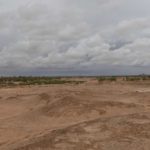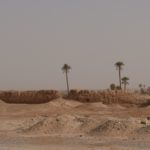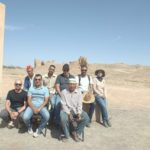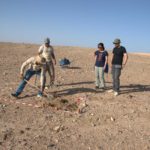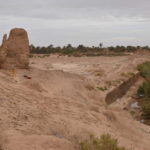Sijilmassa
Sijilmasa, Sid̲j̲ilmāsa,
Historical name: Sijilmassa
Arabic name: سجلماسة
Berber name: ⵙⵉⵊⵉⵍⵎⴰⵙⴰ
-
Project name:
Moroccan-Polish Research Project in Sijilmassa
Projet de recherche maroco-polonais à Sijilmassa
-
Type of site:
Urban settlement, oasis
Location:
Morocco
Draa/Tafilalet
Historical province of: TafilaletDating:
Assumed to have existed from the 8th century to the 16th century.
Most interesting features:
– massive walls made of packed earth
– Alaouite-period mosque and Quranic school
– Alaouite-period settlement
History of research:
Dates of PCMA expedition’s work:
2024–
Type of research:
excavations, survey
Directors:
- Lahcen Taouchikht (Institut Nationale des Sciences de l’Archéologie et du Patrimoine)
- Mustapha Atki (Université Hassan II de Casablanca, Faculté de Lettre et des Sciences Humaines Ain Chock)
- Lorenzo de Lellis (PCMA UW)
Partners:
– Polish Centre of Mediterranean Archaeology, University of Warsaw
– Institut Nationale des Sciences de l’Archéologie et du Patrimoine (INSAP)
Co-operating institutions:
– University of Casablanca Hassan II, Faculty of Letters and Humanities Ain Chock (Université Hassan II de Casablanca, Faculté de Lettre et des Sciences Humaines Ain Chock)
Description of the site and research:
The name Sijilmassa still conjures images of the oasis and echoes of its former political power and commercial prosperity. As the second Islamic foundation in the Maghreb, the city rapidly ascended to prominence under the Midrarid and Maghrawa rulers. Its strategic location and economic prosperity ensured its significance under subsequent dynasties, including the Almoravids, Almohads, and Merinids. Notably, Sijilmassa served as the birthplace of the Alaouite dynasty.
Today, the archaeological remains of Sijilmassa occupy an area of over seventy-five hectares bordering the modern city of Rissani. While previous research projects have investigated certain aspects of the site, a considerable portion of its history remains unexplored. The Moroccan-Polish research project aims to elucidate the multifaceted history of Sijilmassa, encompassing its urban development, historical significance, role in the trans-Saharan trade, and the daily lives of its inhabitants. A collaborative research team composed of Moroccan and Polish scholars employs diverse methodologies to elucidate the city’s architectural, economic, and social dimensions.
Research results:
Events connected with the project:
Project bibliography:
Gallery:
-
View from the walls of Sijilmassa (Photo L. de Lellis/PCMA UW)
-
The packed-earth walls of the oasis town of Sijilmassa (Photo L. de Lellis/PCMA UW)
-
Field team at the end of the season (Photo by L. de Lellis/PCMA UW)
-
Execution of test trenches to confirm the results of geophysics (Photo by M. Atki/PCMA UW)
-
Topographic work in the area of sector 3 (Photo by L. de Lellis/PCMA UW)



